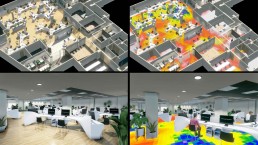
Workplaces.ai
Zaha Hadid Architects (UK) Tyson Hosmer (UK)
Mindspaces – Inspiring Workplaces
An interactive application called Workplaces.ai has been developed by Zaha Hadid Architects’ ZH-Social Research Group as part of the Mindspaces STARTS project. The team focuses on the development of a new methodology for the comparative appraisal of the social functionality of design options, by investigating the social interaction processes to be expected in architectural environments via agent-based simulations with differentiated agent populations and autonomous decision processes. Through this process, it studies the relationship between human life process behaviour in relation to architecture to actively measure and predict social behaviour in the spaces we design. The research focuses on designing workspaces with high social performance, while expanding to investigate social interaction processes in virtual environments and events. The group aims to understand how features in built environments communicate with users and influence their collective behaviour, enabling the design of architecture with high social performance. The research involves three main components developed in parallel: 1) an agent-based computational framework for simulating and analysing the behaviour of social crowds in relation to architectural space planning. People are modelled as cognitive agents with individual internal and external state parameters, perception, and an autonomous decision-making framework to act within designed architectural environments while generating collective occupancy data; 2) a generative design model for workplace space planning, using machine learning to generate high performance layouts negotiating between a series of social and spatial performance criteria analysed through simulations; 3) an immersive experiential simulator enables users to experience and interact with designed virtual environments, while studying their behaviour in relation to them. The Workplaces.ai interactive app allows a user to enter two modes. The first enables the user to generate workplace design options by adjusting parameters which drive the model’s decisions. The second allows the user to immersively enter the virtual model, navigate and interact with it, while the social simulation runs with autonomous agents interacting within the virtual workplace environment. A series of data maps can be visualized describing the collective behaviour of the agent-based simulation in relation to the design. The program includes a menu system with options and instructions for how the user can interact with the application.

Credits
Patrik Schumacher – Chief Researcher Tyson Hosmer – Team Leader Team: Ziming He Soungmin Yu Sobitha Ravichandran Baris Erdincer
Acknowledgements
MindSpaces Consortium
Centre for Research and Technology, Hellas, University of Maastricht, Pompeu Fabra University, Aristotle University of Thessaloniki, McNeel Europe SL, Up2Metric, Nurogames,Zaha Hadid Architects, Maurice Benayoun, Analog Native , Espronceda, e-Sèniors, The town of L’Hospitalet de Llobregat,The university of Hong Kong)
Artists
Maurice Benayoun
Refik Anadol
Artists in residency
Haseeb Ahmed, Sarah Derat, Emanuel Gollob, Emmanuel Van der Auwera, João Martinho Moura, Michael Sedbon
